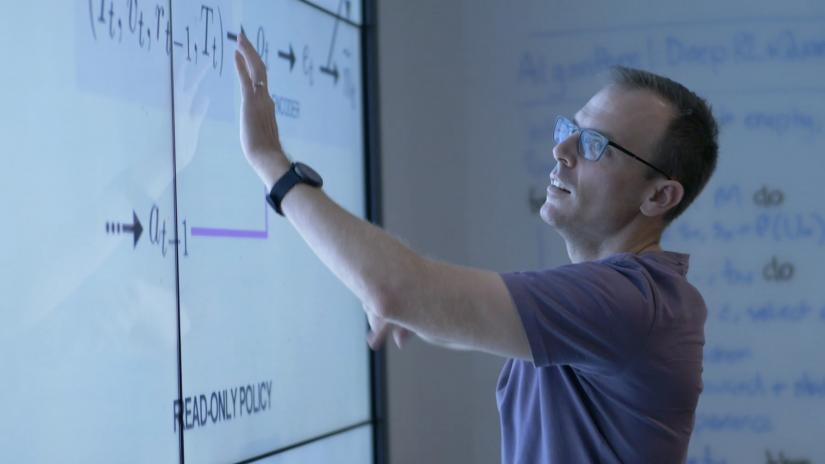The road to a quantum future may be longer and more winding than some expect, but the potential it holds is profound, writes UTS Associate Professor Chris Ferrie.

IBM Q System One Quantum Computer. Image: Adobe Stock by AA+W
If the Sydney Harbour Bridge was rebuilt today engineers would design, build and test the new bridge in virtual worlds before a sod of dirt was turned.
Digital simulation has revolutionised science and technology, improving efficiency, reducing costs and significantly mitigating risks.
It could also do the same for medicine.
Today, drugs are not designed so much as ‘discovered’ because digital computers can’t simulate the molecular interactions within the human body, and hence can’t provide invaluable insights that would propel the development of novel treatments and cures.
Herein lies the promise of quantum computers.
In the future, chemistry will be simulated on quantum computers to design and test new drugs, materials and exotic new forms of matter.
Only time will tell if this will be a utopia, a technological doomsday scenario or just the mundane steady march of progress.
A quantum algorithm is a step-by-step set of instructions that changes quantum information, much like a conventional algorithm is a step-by-step set of instructions that changes digital information (the bits and bytes of your mobile phone and other computers).

UTS Associate Professor Chris Ferrie.
Quantum information is encoded by the fine details of energy and matter, revealed over the last century by quantum physics and controllable by precision engineering at the microscopic scale.
Rather than the 0s and 1s of digital technology, quantum bits (or qubits) can be represented by long lists of numbers.
In the 1990s, it was discovered some problems could be solved with far fewer steps if they were encoded in qubits rather than bits.
This shortcut was so enticing, an international scientific effort began to build machines to do this in a fast and reliable way.
These machines are called quantum computers, and 30 years later, proof of principle prototype devices have been successfully built.
Quantum computer science researchers have compiled a list, called the Quantum Algorithm Zoo, of over 60 quantum algorithms that are believed to run in fewer steps than the best classical algorithm for the same problem.
The first on the list is also the most famous — Shor’s factoring algorithm. Factoring is the process of breaking a large number (like 21) into the smaller numbers which produce it through multiplication (21 = 7 × 3).
For very large numbers, this is such a difficult problem for digital computers that the vast majority of communication systems (like the internet) use it for security.
However, Shor’s algorithm requires far fewer steps to solve the problem, which is a big deal for privacy and security.
Many problems can be thought of as a search for the best solution among a large list of possible solutions.
Grover’s search algorithm is another famous quantum algorithm that takes fewer steps to reach an answer than a classical search algorithm for especially difficult problems.
It’s not yet known which real world problems will yield a significant practical advantage, but difficult problems of this type abound in critical areas including climate modelling, financial portfolio optimisation and artificial intelligence.
More recently, researchers have suggested and provided proof of principle examples of training quantum devices to learn through examples, potentially ushering in a new paradigm of artificial intelligence.
Accurate simulation of chemical interactions require calculations arising from the theory of quantum physics. These are required to design new drugs, fertilisers, batteries and other materials.
The details of how practical a quantum computer might be in any particular instance are yet to be worked out, but a programmable quantum computer could virtually mimic the real world at this fundamental level in principle.
Often, the real transformative power of a technology lies not in its immediate applications, but in the ones that can’t be foreseen.
Reflecting on the early days of the internet, few could have predicted the advent of online shopping, social media, or streaming services.
Similarly, while it is anticipated quantum technology will revolutionise fields like cryptography, drug discovery and climate modelling, its ultimate impact could be something that can’t yet be conceived.
With all of this potential comes a lot of hype. But that must be tempered with a dose of reality.
In the past decade, quantum computers have slowly moved out of university physics departments into the engineering laboratories of large multinational corporations and start-up companies.
Research has transitioned from pure scientific discovery to being in service of specific engineering challenges. Indeed, these are some of the greatest challenges humanity has ever faced.
Quantum computers currently require extremely low temperatures or ultra-high vacuum to operate.
The degrees of freedom that encode quantum information are fragile — every stray particle they come in contact with is likely to cause an irreparable error.
Whereas the lifetime of a bit currently encoding your digital information might be billions of years, the lifetime of today’s qubits is a thousandth of a second.
Still, there has been a steady march of improvement in quantum technology over the past few decades.
History teaches us that technology transitions tend to be slower than initial hype predicts. The transition to quantum technology won’t be like flipping a switch — it will continue to be a gradual process.
To bring this all into perspective, it must be remembered that fear often arises from the unknown.
The complexities of quantum technology can be daunting, but that does not mean they are insurmountable.
The road to a quantum future may be longer and more winding than some expect, but the potential it holds is profound. And so, it is with a realistic yet optimistic lens that humanity should approach this emerging technology.
Who’s afraid of quantum technology? Perhaps those who fear change, the unknown, or the challenges that inevitably accompany technological breakthroughs.
Yet, embracing quantum technology might be less about overcoming fear and more about fostering understanding, encouraging patience, and maintaining an open mind to the unlimited possibilities this technology promises to bring.
Associate Professor Chris Ferrie is a quantum researcher at the University of Technology Sydney’s Centre for Quantum Software and Information. His research interests include quantum estimation and control, and in particular, the use of machine learning to solve statistical problems in quantum information science. He is also the author of a number of children’s books including Quantum Computing for Babies.
Originally published under Creative Commons by 360info™.

